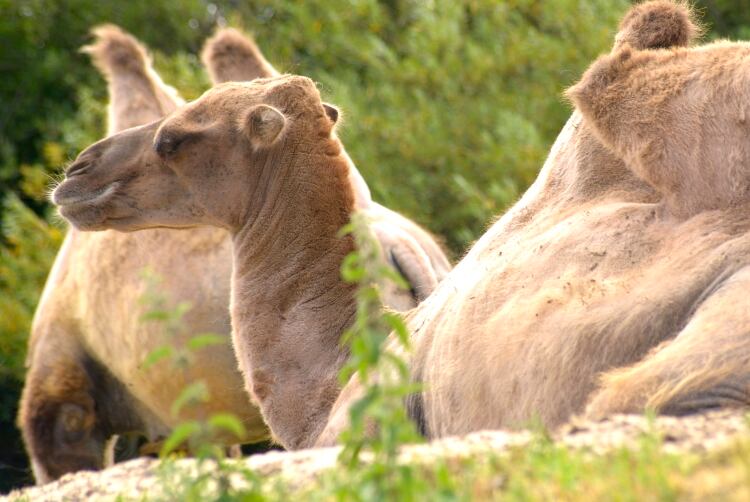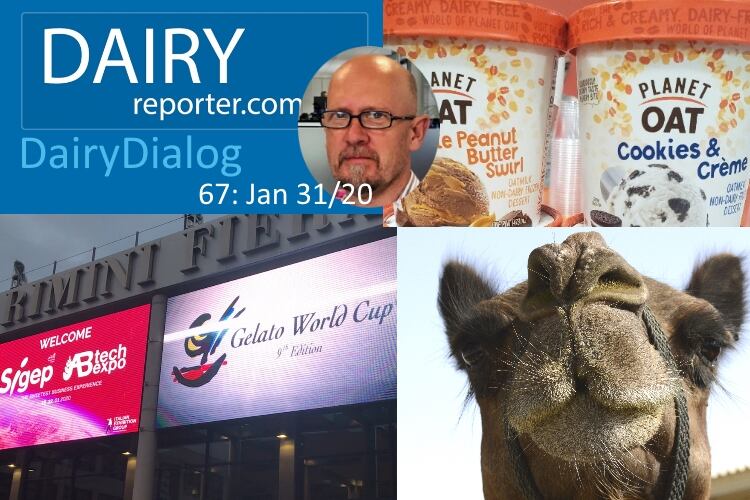The first camels were brought to Australia from India and Afghanistan in the 1840s to provide transport and ferry materials for the construction of railways and infrastructure.
They were released into the wild after motorized transport arrived to take over their duties.
It is believed that numbers have now reached more than 1.2m, and are destined to double again after every 8-10 years, according to Pest Smart. The animals are normally culled by helicopter in remote areas.
Still, the camel remains far less identifiable as an Australian icon than kangaroos, wombats and koalas. But their milk is starting to gain a following among Australians.
Opened in 2015, The Camel Milk Co. of Australia has a milking herd of 70, and the Victorian farm is far larger than it was when Tee Rowe began working there four years ago. Though she had previously been a veterinary nurse and is from the country, she wouldn’t have thought much about camels roaming the Outback.
“You’d say, oh wow, there’s a camel! Plenty of people in Australia don’t realize we have the world’s biggest and only disease-free population. Plenty of people who live in Melbourne don’t even know that,” she said.
The farm is two hours north of Melbourne in hot and dry conditions perfect for camels. Nearly all of its animals are sourced from the Outback and brought to the farm, which houses 450 camels overall.
The dromedaries are far less efficient milk producers than cows. Camel calves take 3-4 years to mature sexually so heifers cannot go back to calf for much longer than cows. Because of this, a more rigorous turnover of animals is needed.
Camels are among the only animals in the world that can be domesticated, released into the wild again and then re-domesticated.
The Camel Milk Co. takes its time to ease the animals into farm life, first putting them into yards where they can settle for a week or two.
“Life just goes on around them, we don’t do anything to them at all. We just allow them to get used to the comings and goings,” said Rowe, who started at the farm milking cows but now handles a number of roles, including exports.
Once a heifer calves, she is left with her calf for a couple of weeks before being introduced to the herd and trained for the dairy.
Everything is done very quietly: only happy camels will provide milk as they have a physical let down to release it, like a human. If she isn’t happy or settled, she won’t let the milk down.
Camels yield an average of 5 liters of milk over two milkings each day, a far cry from cow’s milk production. According to a 2016 Australian government report, "the five years to 2021 are expected to see a major increase in Australian camel milk production” from 50,000 liters per year at the time.
Despite coming at a premium—by some estimates, camel’s milk is 12 times more expensive than cow’s milk—more Australians are finding justification for buying camel’s milk and products from it.
New market
A new market of health- and animal welfare-conscious Australians have been taking to camel’s milk as an alternative to conventional dairy.
Camel’s milk contains about a third less lactose than cow’s milk and doesn’t contain the whey protein beta-lactoglobulin, which is considered one of the main allergens in traditional dairy. On a nutritional level, it is richer than cow's milk in vitamin C, vitamin B, iron, calcium, magnesium and potassium.
What’s more, camel’s milk and human milk are very similar, and are identical in protein size, structure and digestibility.
“Your tummy already knows how to process it. In general, we haven’t come across anyone with a lactose intolerance who hasn’t been able to process camel’s milk,” said Rowe.
“Camel milk is also loaded with naturally occurring anti-inflammatories and antihistamines that really do settle down inflammation or potential allergic reactions.”
Animal-loving consumers also like the way the farm’s animals are treated.
"People might drink nut milk because they don’t agree with how the dairy industry does things, but when they find out that we don’t take the babies away from the mothers and don’t kill what we don’t need, they don’t think it’s too bad,” Rowe added.
The Camel Milk Co. complements its milk bottles with feta cheese and a range of cosmetics that includes camel milk soap and body butter.
The farm currently runs at just 20% capacity with its 70 camels, but these will likely expand to a possible 300 with growth domestically and in export markets.
The Camel Milk Co. already exports to Singapore and Thailand, has a distributor in China and is waiting for the paperwork to be complete before entering Malaysia.
It also uses the daigou grey-market that is well used by Australian health product manufacturers for easy access to China. Using this approach, the company sells freeze-dried powder which can be rehydrated to milk without losing any nutritional quality and enzyme activity. It also sells milk to clients who formulate in Australia before exporting their products to China.
The Middle East might also provide a specialty market, on the back of Australia’s reputation for clean, green agriculture, though it will be difficult for Australian suppliers to meet the economies that come with the scale of production there. Gulf camel farmers have a 6,000-year head start on breeding and milking methods.
For now, The Camel Milk Co. is settling into expansion at pace with its growing market both at home and overseas.


